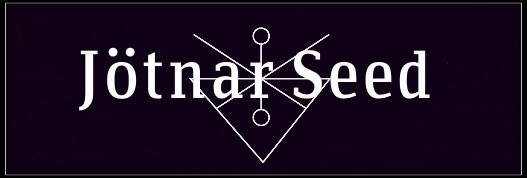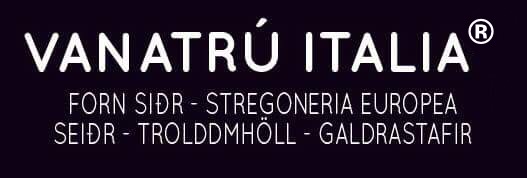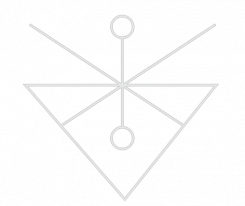Originally published in Alb Italia.
Article in honor of Timo Ketola
The term Grimoire derives from an Old French term ‘gram(m)aire’.
It originally referred to a book written in Latin, but soon this association was more specific to denote a book of magic.
The word grimoire brings us back to the concept of a book full of writing suitable for communication.
Direct communication with the hidden forces of the universe, both demonic and divine.
A common feature of many grimoires is the use of strange alphabets, digits, and signs to represent specific gods, demons, or other hidden forces.
In Scandinavia, precisely in Sweden, black art grimoires were called Svartkonstböcker or Trolldomsböcker witchcraft books;
In Iceland galdrabækur.
Now we are focusing on this kind of art related to Icelandic grimoires.
These texts are particularly distinct from other manuscripts, they diversify because they contain a specific visual element, the galdrastafir, an elaborate pentagram often present in the pages and central component of many spells.
This style creates a single corpus alive throughout the library. Unlike continental grimoires, which tend to refer only to Greek-Mediterranean and Judeo-Christian deities and demons, the Icelandic ones retain considerable vestiges of Germanic pagan folklore; characteristics of which all our work collects.
Icelandic grimoires have played a significant role in the religious history of this magnificent land, as Magnús Rafnsson explains: “Nearly a third of the known witchcraft trials in Iceland revolve around ‘sticks’ and magical signs, grimoires and pages with occult writings. In some cases the accused possessed one or more grimoires, in some cases signs and seals had been written on other objects, sometimes pieces of oak, gills or even boats”.
The great contribution made with the accurate study of S. Flowers, which published
in Galdrabók, leaves us a significant step:
“The acceptance of Christianity by Icelanders was in many ways formalistic, marked by lack of conviction even on the part of those who voted to accept it.
Public sacrifices to the Germanic gods were banned, but private practices of traditional faith could continue.
These included the consumption of horse meat and the exposure of unwanted or deformed infants. The conversion to Roman Catholicism was marked by a long and gradual period of transition. This process lasted for several
generations.
There was also an unchanged interest on the part of Icelanders in their native traditions. In the early phase of this historical period, many goðars had just ordained themselves Christian priests without further education or training.
Others performed their religious duties to relatives. This is because the traditional synthesis of ‘religious’ and ‘secular’ authority seemed unchristian. There were also officials known as leiguprestar (hired priests) who were tied to a chief as slaves.
For the first thirty years of this period, Iceland would remain largely pagan in the practice of religion and magic, since there was no one to teach it differently […] ”.
This passage makes us understand how formal and at the same time cryptic was the relationship with Christianity.
If we take a step back, we notice that in pre-Christian times, those who practiced runic magic were usually well-known and honored members of society.
The Galdrabók is older and more complete.
The original manuscript of this collection of magical spells was written in Iceland starting in the latter part of the 1500s.
It is therefore a product of the Age of Reformation.
The Danish philologist J.G. Sparfvenfelt purchased the book in 1682. It was later sent to Sweden and acquired by the Royal Swedish Academy of Sciences in Stockholm, where it is now kept.
The contents of the Galdrabók demonstrate the presence of two different types of magic.
One type works by means of a prayer formula in which higher powers are invoked for an essentially indirect end.
The second group is a synthesis of signs and symbols that become direct expressions of the magician’s will. Will as the primary form of the ritual act.
According to Egill Skallagrímsson these methods are combined so that the general ritual is very similar to that practiced in ancient times.
This same characteristic accompanies us in the works of recovery and research of the archetypal order of knowledge.
Since the end of the 18th century we have a continuous record of magical manuals composed in the modern period. Most of these date back to the 1800s, but their content dates back to at least the 1700s.
If we examine the Huld manuscript we know that it was compiled by Geir Vigfússon of Akureyri, who died in 1880. The spells contained in this collection are, however, much older. For example, many are comparable to those appearing in Galdrabók.
[…]
To know more, check this


For more information:
Laugrith Heid, La Stregoneria dei Vani, Anaelsas edizioni.
Laugrith Heid, Kindirúnar, Le Rune della Stirpe, Il Grimorio Necromantico, Anaelsas edizioni.
Laugrith Heid, Rún, i tre aspetti di una Runa, Anaelsas edizioni.
Laugrith Heid, Helvíti Svarturgaldur, Manuale pratico di Opera Necromantica Nord Europea, Anaelsas edizioni.
Laugrith Heid, Tröld*R: il Fjölkynngisbók. Magia, Stregoneria e Folk Nord Europeo, Anaelsas edizioni.
+++
For further information:
THE GALDRABÓK tradotto da Stephen E.Flowers,
Northern Magic di Edred Thorsson,
Icelandic Magic di Stephen E. Flowers
*Shares without reference to the source are subject to complaint, since the elements of copyright established by italian law are infringed*

Ylenia Oliverio
Fondatrice e docente dell'Accademia Vanatrú Italia.
Laureata in Filosofia e Storia, Master post Laurea in Beni Archeologici, Master in Preserving and Increasing Value of Cultural Heritage, conseguito a Roskilde (Copenaghen), ulteriore integramento post Laurea.
Archeologo da oltre 13 anni, specializzata in scavo dei cantieri urbani, ha incentrato la sua attenzione verso i culti dell’Europa del Nord e dell'Euroasia durante la sua permanenza nel Canton Ticino per stages formativi al Centro Studi Internazionali Luganesi.
Svolge attività di formazione e informazione, in Italia e in Europa, per la promozione, divulgazione e rivalutazione del Culto Vanico, del Paganesimo puro e degli Antichi Culti dell’Europa ed Euroasia.
Il primo incontro con la Stregoneria Tradizionale è avvenuto nel 1990.

